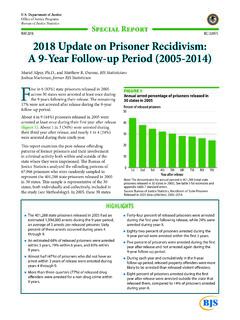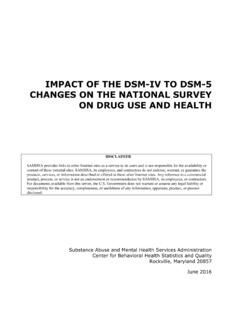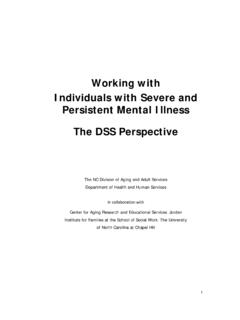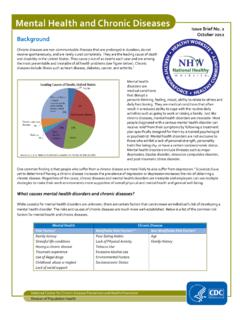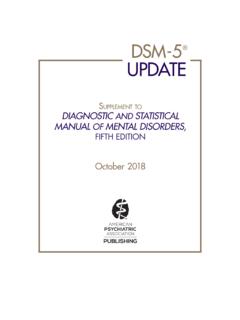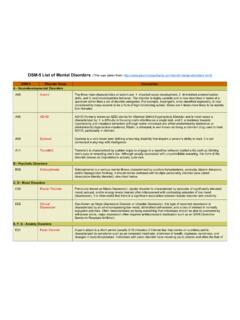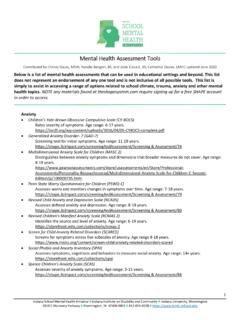Transcription of Indicators of Mental Health Problems Reported by Prisoners …
1 Department of Justice Office of Justice Programs Bureau of Justice StatisticsSpecial ReportIndicators of Mental Health Problems Reported by Prisoners and Jail Inmates, 2011-12 JUNE 2017 NCJ 250612 HIGHLIGHTS More jail inmates (26%) than Prisoners (14%) met the threshold for serious psychological distress (SPD) in the past 30 days. Among those who had been told they had a Mental disorder, the largest percentage of Prisoners (24%) and jail inmates (31%) Reported they had a major depressive disorder. More Prisoners (14%) and jail inmates (26%) met the threshold for SPD in the past 30 days than the standardized general population (5%). Prescription medication was the most common treatment type for Prisoners and jail inmates who met the threshold for SPD in the past 30 days. Fourteen percent of Prisoners and 10% of jail inmates who met the threshold for SPD in the past 30 days were written up or charged with assault.
2 A larger percentage of females in prison (20%) or jail (32%) than males in prison (14%) or jail (26%) met the threshold for SPD in the past 30 days. More white Prisoners and jail inmates met the threshold for SPD in the past 30 days than black or Hispanic Prisoners and jail inmates. Prisoners incarcerated for a violent crime (17%) were as likely as those incarcerated for a property crime (16%) to have met the threshold for SPD in the past 30 days. 010203040506070 Prisoners *Jail inmatesNo indication of a mentalhealth problemcHistory of a Mental Health problembSerious psychologicaldistressaPercentPrisoners*J ail inmates**Figure 1 Mental Health status of Prisoners and jail inmates, by type of Mental Health indicator, 2011 2012 Note: See appendix table 3 for percentages, standard errors, and significance tests. *Comparison group.**Difference with the comparison group is significant at the 95% confidence inmates with a score of 13 or more on the K6 scale.
3 See inmates who Reported they had ever been told by a Mental Health professional they had a Mental inmates with a score of 7 or less on the K6 and who had never been told by a Mental Health professional they had a Mental disorder. Source: Bureau of Justice Statistics, National Inmate Survey, 2011 1 in 7 state and federal Prisoners (14%) and 1 in 4 jail inmates (26%) Reported experiences that met the threshold for serious psychological distress (SPD) in the 30 days prior to a survey that was conducted between February 2011 and May 2012 (figure 1). Similarly, 37% of Prisoners and 44% of jail inmates had been told in the past by a Mental Health professional that they had a Mental disorder. Half of Prisoners (50%) and a third of jail inmates (36%) either did not meet the threshold for SPD or had not been told they had a Mental Health report presents two prevalence estimates of Mental Health Problems among state and federal Prisoners and local jail inmates: met the threshold for SPD and told by a Mental Health professional as having a Mental disorder.
4 The Kessler 6 (K6) nonspecific psychological distress scale was used to assess SPD among Prisoners and jail inmates in the 30 days prior to the survey. The estimates are from self- Reported data and should not be interpreted as representing a clinical diagnosis of a Mental disorder. (See Measurement of Mental Health Indicators text box.) In this report, SPD in the past 30 days prior to the interview is defined as a current Mental Health problem. In this report having ever been told by a Mental Health professional as having a Mental disorder is defined as having a history of a Mental Health Bronson, , BJS StatisticianMarcus Berzofsky, Dr. , RTI International2 Indicators OF Mental Health Problems Reported BY Prisoners AND JAIL INMATES, 2011ff12 | JUNE 2017 Measurement of Mental Health indicatorsThe 2011-12 National Inmate Survey (NIS-3) assessed the prevalence of serious psychological distress (SPD) in the 30 days prior to the interview and the percentage who had ever been told they had a Mental disorder by a Mental Health professional.
5 These two measures are used as Indicators that an inmate likely has a current Mental Health problem or a history of a Mental Health problem. The estimates are from self- Reported data and should not be interpreted as representing a clinical diagnosis of a Mental disorder. Findings also should not be used to infer causation between an indicator of a Mental Health problem and incarceration, because the temporal relationship is unknown. SPD The Kessler 6 (K6) nonspecific psychological distress scale was used to assess those who met the threshold for SPD in the 30 days prior to the interview. The K6 is a six-question tool developed to screen for serious Mental illness among adults age 18 or older in the general population, with a score of 13 or higher indicating Inmates were asked how often during the 30 days prior to the interview they felt nervous hopeless restless or fidgety so depressed that nothing could cheer them up everything was an effort response options were (1) all of the time, (2) most of the time, (3) some of the time, (4) a little of the time, and (5) none of the time.
6 The responses were recoded from 4 to 0, with 4 assigned to all of the time and 0 assigned to none of the time. A summary scale with a range of 0 to 24 was then produced by combining the responses from all six items. Inmates with a score of 13 or higher were considered to have SPD, inmates with a score of 8 to 12 were considered to have an anxiety disorder (not Reported ), and inmates with a score of 7 or fewer were considered to not have an indicator of a current Mental Health problem (see Methodology).History of a Mental Health problem This measure is based on the question, Have you ever been told by a Mental Health professional, such as a psychiatrist or psychologist, that you had (1) manic depression, bipolar disorder, or mania; (2) a depressive disorder; (3) schizophrenia or another psychotic disorder; (4) post-traumatic stress disorder; (5) another anxiety disorder, such as panic disorder or obsessive compulsive disorder; (6) a personality disorder, such as antisocial or borderline personality ; or (7) a Mental or emotional condition other than those listed above?
7 Inmates who answered positively to this question were considered to have a history of a Mental Health time period in which an inmate was told they had a Mental disorder is unknown ( , told last week or last year). This measure is also affected by a person s access to professional Mental Health care. These two Indicators are not mutually exclusive. An inmate could have met the threshold for SPD and a history of a Mental Health disorder. Relatedly, an inmate may have met the threshold for SPD, but not have ever been told by a Mental Health professional that they had a Mental disorder. Or, they could have been told they had a Mental disorder but did not meet the threshold for SPD. Trends are not presented because prior inmate surveys did not include the K6 scale. In addition, prior BJS inmate surveys were collected with different modes ( , audio computer assisted self-interview versus computer-assisted personal interviewing).
8 This could introduce bias when comparing prevalence estimates of Mental Health Indicators across survey years. 1 Kessler, R. C., Barker, P. R., Colpe, L. J., Epstein, J. F., Gfroerer, J. C., Hiripi, E., Howes, M., Zaslavsky, A. M., et al. (2003). Screening for serious Mental illness in the general population. Archives of General Psychiatry, 60(2), 184 189. Kessler, R. C., Green, J. G., Gruber, M. J., Sampson, N. A., Bromet, E., Cuitan, M., Zaslavsky, A. M., et al. (2010). Screening for serious Mental illness in the general population with the K6 screening scale: results from the WHO World Mental Health survey initiative. International Journal of Methods in Psychiatric Research, 19(Supp. 1), report examines the prevalence of the two Mental Health Indicators by different time periods, demographics, criminal justice history, and current offenses. The percentage of inmates who had a Mental Health indicator and who received Mental Health treatment while incarcerated are also presented.
9 Estimates are based on the Bureau of Justice Statistics (BJS) 2011-12 National Inmate Survey (NIS-3). NIS-3 data were self- Reported , and analyses include state and federal Prisoners and local jail inmates. To facilitate comparisons to the general population, data from the National Survey on Drug Use and Health (NSDUH) were standardized to match the prison population and the jail population by age, sex, race, and Hispanic origin (see Methodology). In addition, the general population was divided into three groups based on self- Reported involvement with the criminal justice system in the year prior to the interview: no involvement, under supervision (probation or parole), or OF Mental Health Problems Reported BY Prisoners AND JAIL INMATES, 2011ff12 | JUNE 2017 Prisoners and jail inmates were more likely to have ever been told they had a major depressive disorder than other Mental disorders Prisoners and jail inmates who had been told in the past by a Mental Health professional that they had a Mental disorder were asked to specify the disorder.
10 Nearly a quarter (24%) of the Prisoners who had ever been told they had a Mental disorder said they were told they had major depressive disorder, a larger percentage than any other Mental disorder (table 1). The second most common disorder Reported by Prisoners was bipolar disorder (18%). An estimated 13% of Prisoners Reported they were told they had post-traumatic stress disorder (PTSD) or a personality disorder, such as antisocial or borderline personality disorder. Less than 1 in 10 (9%) Prisoners said they were told they had schizophrenia or another psychotic disorder. Of those jail inmates with a history of a Mental Health problem, 31% had been told they had major depressive disorder, compared to being told they had bipolar disorder (25%), an anxiety disorder (18%), or PTSD (16%). With the exception of personality disorder, jail inmates were more likely than Prisoners to have been told they had each type of Mental and jail inmates were three to five times as likely to have met the threshold for SPD as adults in the general population The percentage of Prisoners who met the threshold for SPD (14%) was more than three times that of adults in the standardized total general population (5%) or those in the standardized general population with no criminal involvement in the past year (4%) (figure 2).







